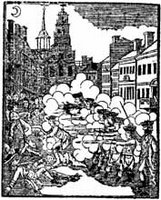Among the people on the scene was Benjamin Burdick, Jr., constable of the town house watch. He testified about what he saw in multiple forums. Burdick’s most detailed account appears in the town’s Short Narrative of the Horrid Massacre, and in part it says:
I then looked round to see what number of inhabitants were in the street, and computed them to be about fifty, who were then going off as fast as possible; at the same time I observed a tall man standing on my left-hand, who seemed not apprehensive of the danger he was in, and before I had time to speak to him, I heard the word “Fire!” and immediately the report followed, the man on my left hand dropped, I asked him if he was hurt, but received no answer, I then stooped down and saw him gasping and struggling with death. I then saw another man laying dead on my right-hand, but further advanced up the street.At the soldiers’ trial the shorthand expert John Hodgson, who was a relative newcomer to town and didn’t know everyone, quoted Burdick this way:
I then saw the soldiers loading again, and I ran up the street to get some assistance to carry off the dead and wounded. Doctor Jos. Gardner, and David Bradley, came down with me to the corpses, and as we were stooping to take them up, the soldiers presented at us again; I then saw an officer passing busily behind them. We carried off the dead without regarding the soldiers.
When the Molatto man was dead, I went up, and met Dr. Gardner and Mr. Brindley. I asked them to come and see the Molatto, and as we stooped to take up the man, the soldiers presented their arms again, as if they had been going to fire, Capt. [Thomas] Preston came, pushed up their guns, and said stop firing, do not fire.“Mr. Brindley” is clearly the man Burdick knew as “David Bradley.”
The tailor David Bradlee was thus at three violent political events in Boston in the space of five months: the tarring and feathering of George Gailer on 28 Oct 1769, the fatal confrontation at Richardson’s house on 22 Feb 1770, and the Massacre.
Furthermore, Bradlee was willing to walk under the guns of the British troops to help pick up Crispus Attucks’s body.
We write a lot about the Boston “crowd” and the “Sons of Liberty” as a collective actor, but of course that group was made up of individual people. David Bradlee was evidently one of those people. He did the work of resisting Crown authority at the street level. He was part of the crowd that genteel political leaders like Samuel Adams, James Otis, and William Molineux relied upon.
COMING UP: The Bradlees and the Tea Party.

No comments:
Post a Comment